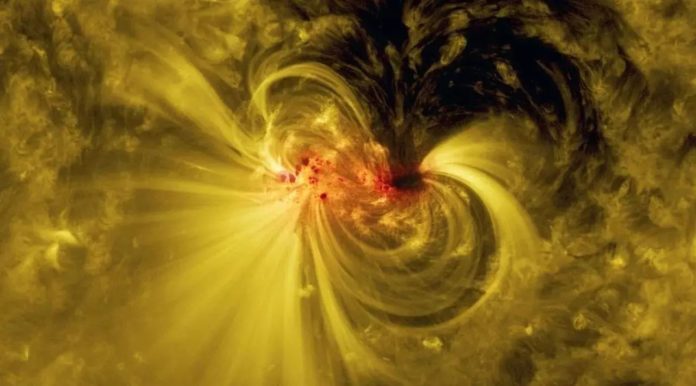The Sun’s corona remained a puzzle even for the scientists who study it closely. It is more than a hundred times hotter than lower layers much closer to the fusion reactor at the Sun’s core.
Now, scientists at the New Jersey Institute of Technology have recently identified a marvel that may start to unravel what they call “one of the greatest challenges for solar modeling” – deciding the physical components that warmth the upper climate to 1 million degrees Fahrenheit and higher.
Scientists did observations from the NASA’s space-based Solar Dynamics Observatory (SDO). They identified regions in the corona with elevated levels of heavy metal ions contained in magnetic flux tubes – concentrations of magnetic fields – which carry an electrical current.
Their vivid images, captured in the extreme (shortwave) ultraviolet (EUV) band, reveal disproportionally large – by a factor of five or more – concentrations of multiply charged metals compared to single-electron ions of hydrogen than exist in the photosphere.
They found the iron particles live in “ion traps” situated at the base of coronal loops, arcs of zapped plasma coordinated by attractive field lines. The presence of these traps infers that there are exceptionally vigorous coronal loops, drained of iron particles, which have thus far escaped recognition in the EUV range. Just metal ions, with their fluctuating electrons, deliver outflows which make them obvious.
The metal ions enter the corona when variously sized solar flares destroy the traps, and they are evaporated into flux loops in the upper atmosphere.
Fleishman, a distinguished research professor of physics said, “We knew that something really intriguing happens at the interface between the photosphere – the Sun’s surface – and the corona, given the noticeable disparities in the chemical composition between the two layers and the sharp rise in plasma temperatures at this junction.”
“These observations suggest that the corona may contain even more thermal energy than is directly observed in the EUV range and that we have not yet accounted for. This energy is visible in other wavelengths, however, and we hope to combine our data with scientists who view it through microwaves and X-rays, such as scientists at NJIT’s Expanded Owens Valley Solar Array, for example, to clarify mismatches in energy that we’ve been able to quantify so far.”
He noted, “Before we can address how energy is generated in the corona, we must first map and quantify its thermal structure.”
“What we know of the corona’s temperature comes from measuring EUV emissions produced by heavy ions in various states of ionization, which depends on their concentrations, as well as plasma temperature and density. The non-uniform distribution of these ions in space and time appears to affect the temperature of the corona.”
Energy releases in solar flares and related types of ejections happen when magnetic field lines, with their intense electric streams, are bent beyond a critical point that can be estimated by the number of turns in the wind.
The largest eruption causes radiation, energetic particles and magnetic field releases from the Sun powerful enough to cause severe effects in Earth’s near environment, such as the disruption of communications, power lines and navigation systems.
Fleishman said, “Prior to these observations, we have only accounted for the coronal loops filled with heavy ions, but we could not account for flux tubes depleted of them.”
“Now all of these poorly understood phenomena have a solid physical foundation that we can observe. We are able to better quantify the corona’s thermal structure and gain a clearer understanding of why ion distribution in the solar atmosphere is non-uniform in space and variable in time.”
“EUV emissions, however, can only be observed from space. The SDO, aboard a spacecraft launched in 2010, measures both magnetic field and EUV emissions from the whole Sun. The implications of the corona’s temperature structure, and whether it allows the Sun to transfer more heat into the solar system, is the subject of future study.”
Their findings, which account for previously undetected thermal energy in the corona, were recently published in the 123-year-old Astrophysical Journal.
